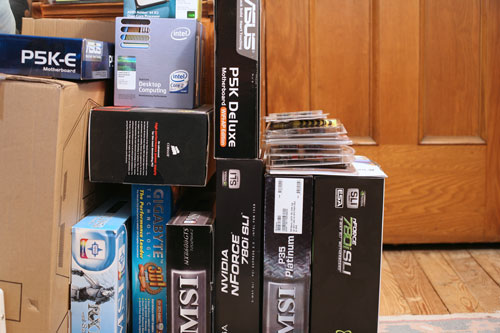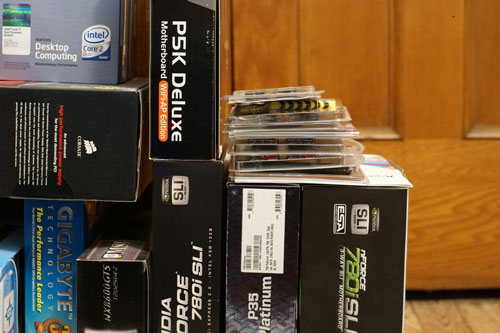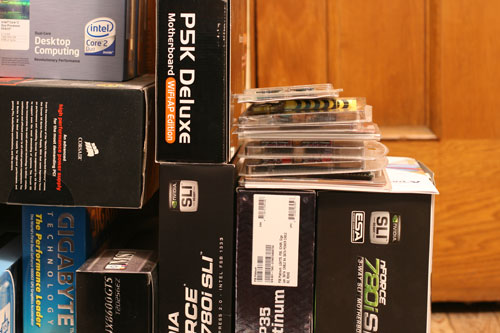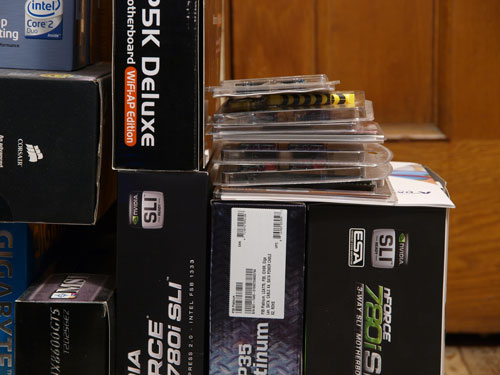The Digital Sensor: A Guide to Understanding Digital Cameras
by Wesley Fink on April 21, 2008 1:00 AM EST- Posted in
- Digital Camera
Field of View
Now that you have some basic understanding of digital camera sensors, it is time to take a closer look at the practical considerations that are created by these differences in sensors. A very poorly understood concept is the lens multiplier with the smaller than 35mm sensor-size that is used in most digital SLR cameras. The best way to illustrate this is with actual photos taken by a range of digital SLR cameras from the same tripod location.
We shot the same view using the exact same tripod location on a range of current digital SLR cameras. Each camera used a lens with the same focal length of 50mm. Lighting was the same with a 100W high-right light source, camera aperture was f4.0 in all cases, and white balance was set to Tungsten. The purpose of this series is to illustrate what you can see with each camera with the same lens, so exposure data is somewhat irrelevant, but exposure conditions were kept as constant as possible for reference.

The Canon EOS 5D is a full-frame SLR, which means the sensor is the same size as 35mm film. This point of view is the way an image at this distance would look on the Nikon D3, Canon 1Ds III, Canon 5D, and 35mm film cameras. The APS-H sensor used in a few Canon pro models is 1.3X and falls between full frame and 1.5X in its field of view.

The 1.5X multiplier is typical of cameras based on the Sony and Samsung sensors. This includes the Sony A700/A350/A300/A200/A100, the Nikon D300/D200/D80/D60/D40x/D40, the Pentax K20D/K10D/K200D/K100D, and all Samsung digital SLRs.

Canon introduced the small APS C sensor in the pioneering D30 and they have kept this size for consumer cameras since. This field of view is typical of the Canon 40D/XTi/XSi. The Foveon sensor Sigma SD14 has a 1.7X lens multiplier and falls between this small APS C Canon sensor and the 4/3 system.











72 Comments
View All Comments
bjacobson - Tuesday, April 22, 2008 - link
Infrared is largely not done due to issues with privacy.TETRONG - Tuesday, April 22, 2008 - link
No worriesThis company is making anti-infrared underwear
http://www.cramer.co.jp/products/guardshorts.html">http://www.cramer.co.jp/products/guardshorts.html
aliasfox - Monday, April 21, 2008 - link
When everybody was still on 35mm film, it was impossible to tell whether an SLR shot an image or a good point and shoot/rangefinder style camera. Image noise was a function of the film, and within a certain range, SLRs and point and shoots could reproduce the same sharpness and depth of field. All of that is pretty much impossible these days with the split in sensor sizes.My biggest question is: if camera companies could make a pocketable 35mm/APS sized camera 10 years ago, why can't they make the same pocketable size with a digital sensor? An APS-C sized sensor in a Canon G9-style body shouldn't be impossible, and while it would be expensive, it would have image quality worth the price.
I have a feeling that the companies producing SLRs are just trying to protect their high-margin lens business - a company that's not vested in the SLR side of things could carve out a very solid niche by making a point and shoot with an SLR sensor.
And yes, I know the Sigma DP1 exists, but without a zoom lens and max aperture of F4.0, $800 is a lot to ask...
idealego - Wednesday, April 23, 2008 - link
A lot of it has to do with consumers expecting zoom lenses with cameras. The larger the sensor the larger the lens has to be, especially with a zoom lens. I don't think it's possible to have a decent zoom lens on a pocketable camera with a large sensor (with current technology). This is why the DP1 has these limitations. This is also why a camera such as the Sony R1 has such a large lens compared to other cameras with smaller sensors.However, I'd be quite happy with a fast prime lens on a well-designed, pocketable, large-sensor camera, even if it did have a bunch of downsides to it.
If the DP1 was more refined and had a much faster lens, it would be an awesome camera. Unfortunately, it's rather crude compared to cameras from other leading brands.
Johnmcl7 - Monday, April 21, 2008 - link
"My biggest question is: if camera companies could make a pocketable 35mm/APS sized camera 10 years ago, why can't they make the same pocketable size with a digital sensor? An APS-C sized sensor in a Canon G9-style body shouldn't be impossible, and while it would be expensive, it would have image quality worth the price.I have a feeling that the companies producing SLRs are just trying to protect their high-margin lens business - a company that's not vested in the SLR side of things could carve out a very solid niche by making a point and shoot with an SLR sensor. "
I don't think that's the case at all, film and digital cameras have to be a lot more different than you perhaps appreciate. The Sigma DP1 has had a prolonged and difficult development, while I think that's partially because Sigma are less experienced it's not entirely the story. One of the main problems I believe is the way light hits the sensor, with a digital sensor to work optimally you need to have the light hitting the sensor as straight as possible. Film was more flexible in this sense which made it easer to produce small cameras using comparatively large pieces of film. I believe this was one of the difficulties in producing the DP1 as the lens is very close to the sensor which meant the light is hitting the sensor at very high angles. This is easier on an SLR as the sensor is a reasonable distance back from the rear of the lens (Olympus particularly have made a goal of telecentric lenses) although even the 35mm full frame cameras can suffer from poor corner sharpness.
Also with film you didn't have any low pass or IR filter in front of the film itself which is normally part of a digital camera, I believe the DP1 (as well as the Leica M8) don't actually have an AA filter at all which causes its own problems.
Hopefully other companies will have a go seeing the interest that the DP1 is generating, I think Panasonic who produce a 4/3 sensor and are having little success in the SLR market are in a prime condition to do so. However it's a more difficult task than it seems.
John
Heidfirst - Monday, April 21, 2008 - link
"I have a feeling that the companies producing SLRs are just trying to protect their high-margin lens business "when Kodak got out of doing DSLR bodies (even if they were basically Nikons with a different sensor) they said it was because the profits weren't in the bodies but in the lenses - which of course they didn't make ...
Pentax is supposed to be getting out of compacts because they're becoming a commodity item & hence price-sensitive/low margin.
I could imagine someone like Leica doing what you want though as they seem able to command a significant premium.
aliasfox - Monday, April 21, 2008 - link
Leica's currently tied to Panasonic sensors, and relatively speaking, Panasonic hasn't figured out how to make a sensor that has low noise above ISO 200 yet, regardless of size (otherwise I'd seriously contemplate the Lumix LX-2).Also, while I'm willing to pay a premium for a nice fixed lens camera (I'll consider up to $700, maybe even $1000 for a camera with the right handling, image quality, and features), the market for such an expensive "small" camera is probably pretty small (unless professionals are all clamoring for a pocketable camera as a backup in the field).
Lastly, the Leica name generally commands an even healthier premium than I'm willing (or financially able) to consider...
pinto4402 - Monday, April 21, 2008 - link
The sensor is only half the story. The lens is the other half. This is NOT marketing hype. The difference between consumer kit lenses and pro series glass is easily discernible (even to non pixel peepers). Does this justify the 8X difference in price? I don't know.However, I'm pretty sure that it's not possible to construct a high quality P&S with a great lens that is "pocketable," regardless of the sensor size. Good glass tends to be heavy. Even the old Leica and Contax rangefinders were not pocket cameras. They were compact, but I doubt anyone considers them pocket cameras (unless you're talking about cargo or jacket pockets, and you trust having a $6000 camera hanging out of your shirt pocket). When you add zoom functions to the equation (which is a must nowadays), you looking at some serious IQ trade-offs.
That said, I would be the first in line to purchase a good P&S camera that produces high quality professional grade images.
aliasfox - Monday, April 21, 2008 - link
Honestly, I'll be happy if someone can fit an under 2" thick camera with an adequate (say, 28-112mm equivalence, f2.8 - f4.0) lens and a large/larger sensor. Maybe not even an APS-C sensor - a 4/3" design is already significantly larger than a 1/1.8" sized unit. Olympus, are you listening?The Olympus E-420, even with its pancake 28mm equivalence lens, is too thick to put into a jacket pocket (or crammed into some looser fitting jeans).
I rarely ever take dedicated trips to take photos - so packing a backpack half full of photographic equipment to take a "nice" shot is something I'm loathe to do. But I do go cycling, hiking, and other normal touristy activities where I'd like to be able to bring a camera along...
strikeback03 - Tuesday, April 22, 2008 - link
There was the Sony R1 - APS-C sensor and 24-120 Zeiss-branded lens. Not exactly pocketable, even not having to deal with the registration distances required by an SLR with the swinging mirror. Maybe if you were willing to do something with folded optics you could fit a zoom in a smaller body, but who knows how much of an image compromise that would be.My XT with 28 1.8 does fit in the cargo pocket of one pair of pants I own, but I would rather just have it in a small shoulder bag.